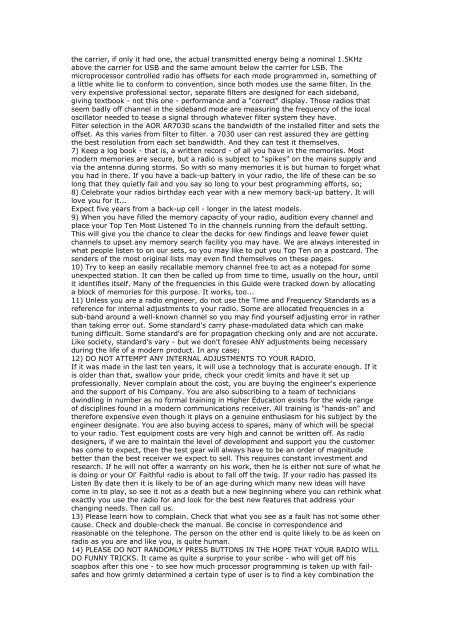Listener's Guide - 1999 - The Listeners Guide
Listener's Guide - 1999 - The Listeners Guide
Listener's Guide - 1999 - The Listeners Guide
You also want an ePaper? Increase the reach of your titles
YUMPU automatically turns print PDFs into web optimized ePapers that Google loves.
the carrier, if only it had one, the actual transmitted energy being a nominal 1.5KHzabove the carrier for USB and the same amount below the carrier for LSB. <strong>The</strong>microprocessor controlled radio has offsets for each mode programmed in, something ofa little white lie to conform to convention, since both modes use the same filter. In thevery expensive professional sector, separate filters are designed for each sideband,giving textbook - not this one - performance and a "correct" display. Those radios thatseem badly off channel in the sideband mode are measuring the frequency of the localoscillator needed to tease a signal through whatever filter system they have.Filter selection in the AOR AR7030 scans the bandwidth of the installed filter and sets theoffset. As this varies from filter to filter. a 7030 user can rest assured they are gettingthe best resolution from each set bandwidth. And they can test it themselves.7) Keep a log book - that is, a written record - of all you have in the memories. Mostmodern memories are secure, but a radio is subject to "spikes" on the mains supply andvia the antenna during storms. So with so many memories it is but human to forget whatyou had in there. If you have a back-up battery in your radio, the life of these can be solong that they quietly fail and you say so long to your best programming efforts, so;8) Celebrate your radios birthday each year with a new memory back-up battery. It willlove you for it...Expect five years from a back-up cell - longer in the latest models.9) When you have filled the memory capacity of your radio, audition every channel andplace your Top Ten Most Listened To in the channels running from the default setting.This will give you the chance to clear the decks for new findings and leave fewer quietchannels to upset any memory search facility you may have. We are always interested inwhat people listen to on our sets, so you may like to put you Top Ten on a postcard. <strong>The</strong>senders of the most original lists may even find themselves on these pages.10) Try to keep an easily recallable memory channel free to act as a notepad for someunexpected station. It can then be called up from time to time, usually on the hour, untilit identifies itself. Many of the frequencies in this <strong>Guide</strong> were tracked down by allocatinga block of memories for this purpose. It works, too...11) Unless you are a radio engineer, do not use the Time and Frequency Standards as areference for internal adjustments to your radio. Some are allocated frequencies in asub-band around a well-known channel so you may find yourself adjusting error in ratherthan taking error out. Some standard's carry phase-modulated data which can maketuning difficult. Some standard's are for propagation checking only and are not accurate.Like society, standard's vary - but we don't foresee ANY adjustments being necessaryduring the life of a modern product. In any case;12) DO NOT ATTEMPT ANY INTERNAL ADJUSTMENTS TO YOUR RADIO.If it was made in the last ten years, it will use a technology that is accurate enough. If itis older than that, swallow your pride, check your credit limits and have it set upprofessionally. Never complain about the cost, you are buying the engineer's experienceand the support of his Company. You are also subscribing to a team of techniciansdwindling in number as no formal training in Higher Education exists for the wide rangeof disciplines found in a modern communications receiver. All training is "hands-on" andtherefore expensive even though it plays on a genuine enthusiasm for his subject by theengineer designate. You are also buying access to spares, many of which will be specialto your radio. Test equipment costs are very high and cannot be written off. As radiodesigners, if we are to maintain the level of development and support you the customerhas come to expect, then the test gear will always have to be an order of magnitudebetter than the best receiver we expect to sell. This requires constant investment andresearch. If he will not offer a warranty on his work, then he is either not sure of what heis doing or your Ol' Faithful radio is about to fall off the twig. If your radio has passed itsListen By date then it is likely to be of an age during which many new ideas will havecome in to play, so see it not as a death but a new beginning where you can rethink whatexactly you use the radio for and look for the best new features that address yourchanging needs. <strong>The</strong>n call us.13) Please learn how to complain. Check that what you see as a fault has not some othercause. Check and double-check the manual. Be concise in correspondence andreasonable on the telephone. <strong>The</strong> person on the other end is quite likely to be as keen onradio as you are and like you, is quite human.14) PLEASE DO NOT RANDOMLY PRESS BUTTONS IN THE HOPE THAT YOUR RADIO WILLDO FUNNY TRICKS. It came as quite a surprise to your scribe - who will get off hissoapbox after this one - to see how much processor programming is taken up with failsafesand how grimly determined a certain type of user is to find a key combination the

















